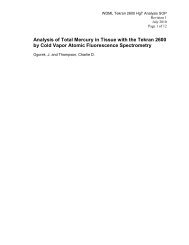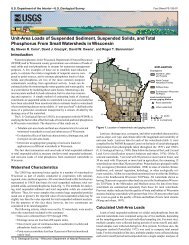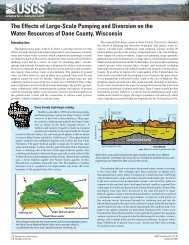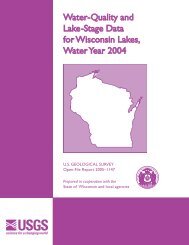Nippon MA-2 Mercury Analyzer - Wisconsin
Nippon MA-2 Mercury Analyzer - Wisconsin
Nippon MA-2 Mercury Analyzer - Wisconsin
You also want an ePaper? Increase the reach of your titles
YUMPU automatically turns print PDFs into web optimized ePapers that Google loves.
clear the sample train of residual mercury, reducing sample carryover. Reagent<br />
blanks within an analytical batch exceeding 0.05 ng/boat indicate contamination<br />
of additive source or persistent systemic contamination. Repeat the preceding<br />
samples of a failed reagent blank up to the last passing reagent blank (< 0.05<br />
ng/boat) or instrumental purge with a peak area < 0.005; if sample carryover is<br />
suspected in this batch, the samples should be bracketed with purges. If reagent<br />
blanks continue to fail the repeated analysis, the additive has become<br />
contaminated and should be combusted.<br />
Instrument Calibration<br />
A standard curve should be (1) created with mercury masses appropriate to the<br />
measurement mode, (2) calculated with a polynomial best fit equation with an<br />
intercept of zero, and (3) have an r 2 value greater than 0.995. The mass of<br />
mercury in analyzed samples should occur within the levels of the standard<br />
curve. Instrumental response tends to be relatively stable over multiple days,<br />
therefore daily calibration is not necessary. However, instrumental calibration<br />
should be verified (± 10%) prior to sample analysis by analysis of a known mass<br />
of mercury from a standard solution.<br />
Additional Instructions<br />
Interferences<br />
The instrument is extremely sensitive to acid and free halogens, which degrade<br />
the catalyst and gold trap. It is very important to reduce/eliminate exposure to<br />
these factors throughout analysis and storage. Saline sediments (such as<br />
marine sediments) and potentially acidified samples should be analyzed<br />
sparingly with the <strong>Nippon</strong> or with an alternative method.<br />
Reagents<br />
Before use, heat reagents to 750 C for 1 hr in 250 ml crucible to volatilize<br />
residual mercury and water. Leave in furnace until cool and transfer back into<br />
original container if not immediately used.<br />
Standard Solution<br />
<strong>Mercury</strong> standards are prepared in a 0.001% L-cysteine, 0.2% Nitric acid<br />
solution; do not use standards prepared in any other matrix as that acids and free<br />
halogens substantially interfere with instrument performance. Standards<br />
solutions of 10, 100, and 10000 ng/ml meet most analytical needs of the<br />
instrument.








